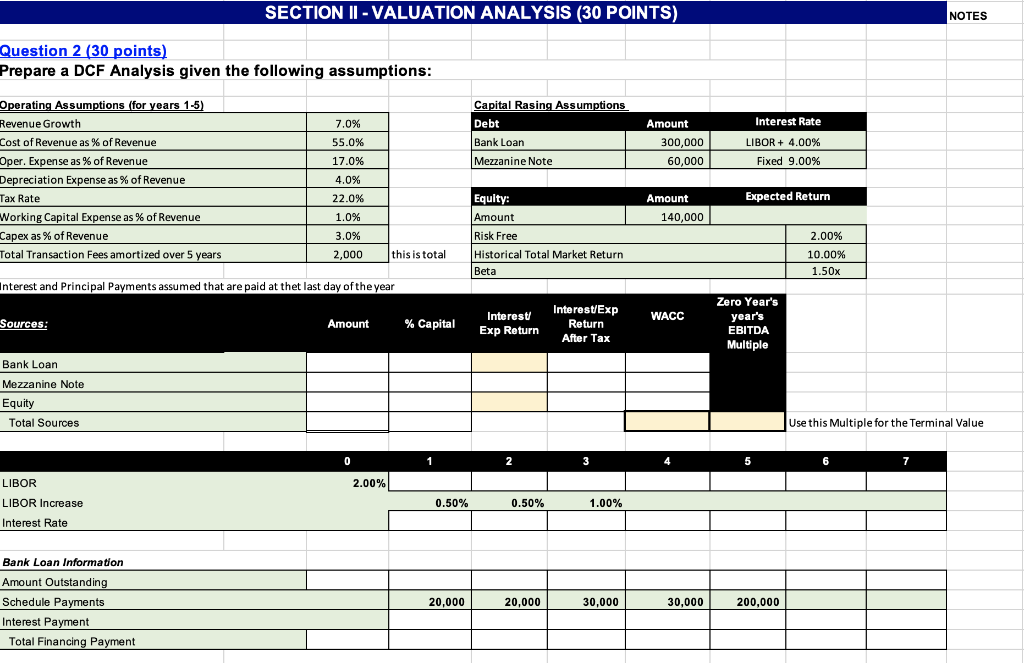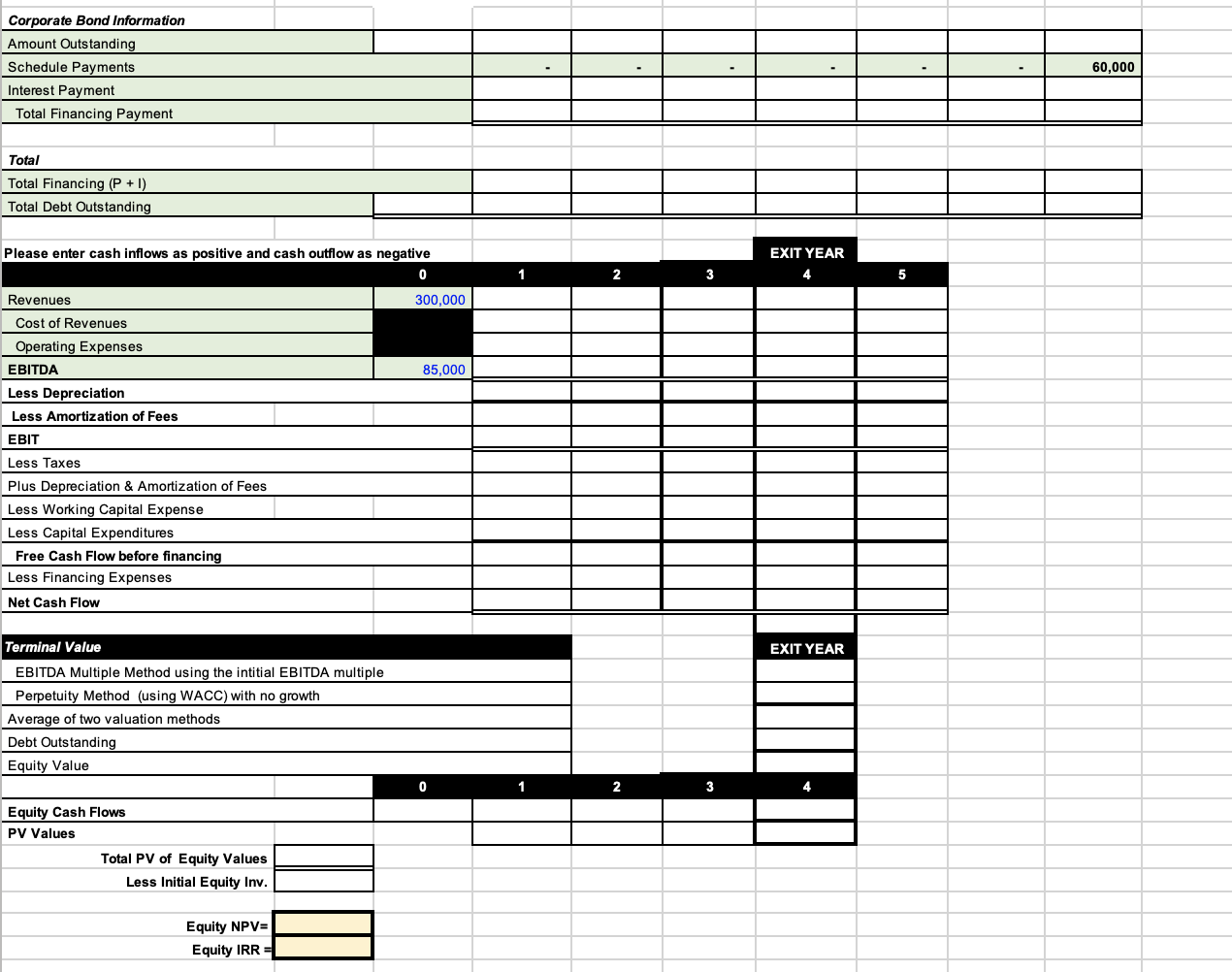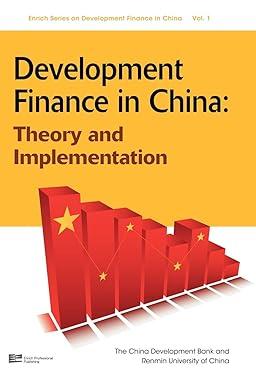Answered step by step
Verified Expert Solution
Question
1 Approved Answer
PLEASE ANSWER asap need all white and yellow boxes with excel formula. SECTION I-VALUATION ANALYSIS (30 POINTS) NOTES Question 2 (30 points) Prepare a DCF


PLEASE ANSWER asap need all white and yellow boxes with excel formula.
SECTION I-VALUATION ANALYSIS (30 POINTS) NOTES Question 2 (30 points) Prepare a DCF Analysis given the following assumptions: 7.0% Capital Rasing Assumptions Debt Bank Loan Mezzanine Note 55.0% Amount 300,000 60,000 Interest Rate LIBOR + 4.00% % Fixed 9.00% Operating Assumptions (for years 1-5) Revenue Growth Cost of Revenue as % of Revenue Oper. Expense as % of Revenue Depreciation Expense as % of Revenue Tax Rate Working Capital Expense as % of Revenue Capex as % of Revenue Total Transaction Fees amortized over 5 years 17.0% 4.0% Expected Return Equity: Amount Amount 140,000 22.0% 1.0% 3.0% 2,000 this is total Risk Free Historical Total Market Return Beta 2.00% 10.00% 1.50x Interest and Principal Payments assumed that are paid at thet last day of the year WACC Sources: Amount % Capital Interest Exp Return Interest/Exp Return After Tax Zero Year's year's EBITDA Multiple Bank Loan Mezzanine Note Equity Total Sources Use this Multiple for the Terminal Value 0 1 2 3 4 5 6 7 LIBOR 2.00% 0.50% 0.50% 1.00% LIBOR Increase Interest Rate Bank Loan Information Amount Outstanding Schedule Payments Interest Payment Total Financing Payment 20,000 20,000 30,000 30,000 200,000 Corporate Bond Information Amount Outstanding Schedule Payments Interest Payment Total Financing Payment 60,000 Total Total Financing (P + 1) Total Debt Outstanding EXIT YEAR Please enter cash inflows as positive and cash outflow as negative 0 1 2 3 4 5 Revenues 300,000 Cost of Revenues Operating Expenses EBITDA Less Depreciation Less Amortization of Fees 85,000 EBIT Less Taxes Plus Depreciation & Amortization of Fees Less Working Capital Expense Less Capital Expenditures Free Cash Flow before financing Less Financing Expenses Net Cash Flow Terminal Value EXIT YEAR EBITDA Multiple Method using the intitial EBITDA multiple Perpetuity Method (using WACC) with no growth Average of two valuation methods Debt Outstanding Equity Value 0 1 2 3 Equity Cash Flows PV Values Total PV of Equity Values Less Initial Equity Inv. Equity NPV= Equity IRR = SECTION I-VALUATION ANALYSIS (30 POINTS) NOTES Question 2 (30 points) Prepare a DCF Analysis given the following assumptions: 7.0% Capital Rasing Assumptions Debt Bank Loan Mezzanine Note 55.0% Amount 300,000 60,000 Interest Rate LIBOR + 4.00% % Fixed 9.00% Operating Assumptions (for years 1-5) Revenue Growth Cost of Revenue as % of Revenue Oper. Expense as % of Revenue Depreciation Expense as % of Revenue Tax Rate Working Capital Expense as % of Revenue Capex as % of Revenue Total Transaction Fees amortized over 5 years 17.0% 4.0% Expected Return Equity: Amount Amount 140,000 22.0% 1.0% 3.0% 2,000 this is total Risk Free Historical Total Market Return Beta 2.00% 10.00% 1.50x Interest and Principal Payments assumed that are paid at thet last day of the year WACC Sources: Amount % Capital Interest Exp Return Interest/Exp Return After Tax Zero Year's year's EBITDA Multiple Bank Loan Mezzanine Note Equity Total Sources Use this Multiple for the Terminal Value 0 1 2 3 4 5 6 7 LIBOR 2.00% 0.50% 0.50% 1.00% LIBOR Increase Interest Rate Bank Loan Information Amount Outstanding Schedule Payments Interest Payment Total Financing Payment 20,000 20,000 30,000 30,000 200,000 Corporate Bond Information Amount Outstanding Schedule Payments Interest Payment Total Financing Payment 60,000 Total Total Financing (P + 1) Total Debt Outstanding EXIT YEAR Please enter cash inflows as positive and cash outflow as negative 0 1 2 3 4 5 Revenues 300,000 Cost of Revenues Operating Expenses EBITDA Less Depreciation Less Amortization of Fees 85,000 EBIT Less Taxes Plus Depreciation & Amortization of Fees Less Working Capital Expense Less Capital Expenditures Free Cash Flow before financing Less Financing Expenses Net Cash Flow Terminal Value EXIT YEAR EBITDA Multiple Method using the intitial EBITDA multiple Perpetuity Method (using WACC) with no growth Average of two valuation methods Debt Outstanding Equity Value 0 1 2 3 Equity Cash Flows PV Values Total PV of Equity Values Less Initial Equity Inv. Equity NPV= Equity IRR =Step by Step Solution
There are 3 Steps involved in it
Step: 1

Get Instant Access to Expert-Tailored Solutions
See step-by-step solutions with expert insights and AI powered tools for academic success
Step: 2

Step: 3

Ace Your Homework with AI
Get the answers you need in no time with our AI-driven, step-by-step assistance
Get Started


